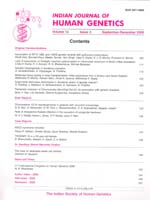
|
Indian Journal of Human Genetics
Medknow Publications on behalf of Indian Society of Human Genetics
ISSN: 0971-6866 EISSN: 1998-362x
Vol. 8, Num. 1, 2002, pp. 3
|
Indian Journal of Human Genetics, Vol. 8, No. 1, Jan-Jun, 2002 pp. 3 Editorial Catching
up with the progress….. Dipika Mohanty Editor, Indian
Journal of Human Genetics Code Number: hg02001 Indian Journal of Human
Genetics has ushered the change of hand. Now, the new Editorial Board is set up
and I as the new Editor see the tremendous task ahead to come out successful fishing
through the troubled water. However, I am hopeful for the same with the hardwork
of myself and my colleagues who will help me in this endeavour. Some of the changes
which are proposed in future for the betterment of the journal has been provided
in this issue and will be implemented in the next issue. The suggestions regarding
this if any may be communicated to the Editorial Board. Facilitation has been
made for the quick publication at each step i.e. manuscript submission, review
by the referee and also for the decision making by the Editorial Board etc. It
is largely due to the progress in the electronic media. This issue deals with
mostly the molecular cytogenetics work exclusively carried out in India. The accuracy
of cytogenetic diagnosis has improved steadily over the past 20 years and India
is not lagging behind as evidenced by the articles in this issue. The impact
of the new FISH techniques in the cytogenetics of haematological malignancies
can not be over emphasised. A range of techniques based around fluorescence in
Situ Hybridization (FISH) have greatly enhanced cytogenetic analysis. These use
a variety of nucleic acid sequences as probes to cellular DNA target and serve
to bridge the gap between molecular genetic and conventional cytogenetic methods.
FISH today is a widespread and diversely applied technology. The list of areas
in which FISH is employed includes karyotype analysis, gene mapping, DNA replication
dosimetry, gene transcription and expression and the study of chromatin organization
as structure. The diversity of application is complemented by a diversity in the
types of probes and detection systems that are currently being employed for FISH
techniques. It is beyond the scope of this Editorial report to describe this sophisticated
technique in detail. However, it is quite heartening to know that many of these
techniques are being applied in clinical practice by our Indian cytogeneticists.
The advances in recombinant nucleic acid technology and ability to clone and amplify
DNA segment in microorganisms has provided richest source of probes for FISH.
The advantage of FISH is that it can be utilised both on metaphase chromosomes
and interphase nuclei and using flow sorted chromosome specific libraries, chromosome
painting had been developed. So, today FISH technique and comparative genomic
hybridization (CGH) for detecting changes in DNA copy throughout tumor genome
and new methods for simultaneous multiprobe hybridization and global visualization
of structural rearrangements has come of age. Furthermore all normal or rearranged
human chromosomes can be unequivocally identified by newly developed procedures
designated as multifuor and spectral karyotype. Thus, the combination of CGH and
multifuor or special karyotype analysis allows identification of all types of
genomic abnormalities in cancer cells. Simultaneous development of fluorescence
microscopy and the introduction of digital imaging have all empowered FISH to
play an important diagnostic role in clinical laboratory. Lastly, I would like
to end with a positive request to all our members for submission of quality articles
which will enable us to raise the standard of the journal. Copyright 2002 -
the Indian Society of Human Genetics
| 